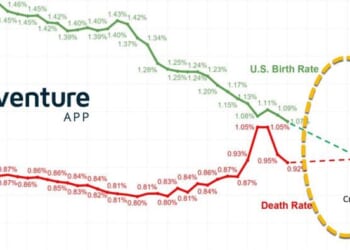
EAST BRUNSWICK, New Jersey—Still stung by President Donald Trump’s commanding 2024 reelection victory, Democrats were steeling for more disappointment.
So, as it dawned on the hundreds of party insiders who filled a hotel ballroom for Mikie Sherrill’s election night gathering that the congresswoman was poised not just to win the Garden State’s closely watched governor’s race but to do so in a landslide, the crowd erupted in celebration—as if reaching the promised land after wandering aimlessly in the desert for the past 12 months. “We’re saying ‘no’ to Donald Trump; we’re saying ‘no’ to MAGA,” New Jersey Democratic Party Chairman LeRoy Jones Jr. thundered from the stage, even before Sherrill was officially declared governor-elect.
The party’s collective exhale Tuesday evening wasn’t just a product of Sherrill outrunning Republican Jack Ciattarelli by more than 13 percentage points (56.3 percent to 43.1 percent) after polling averages showed her leading by 3.3 points and the race tightening down the stretch. Neither was it simply about the breadth of victories in Virginia and the other states with crucial off-year contests—nor even the encouraging demographic shifts back to the Democratic Party after Trump’s gains with Hispanic voters, young voters, and black men last year.
Coupled with the government shutdown Democrats instigated as leverage to force congressional Republicans to reauthorize Obamacare subsidies, the party’s sweep in New Jersey and elsewhere provided a renewed political purpose and possibility ahead of the 2026 midterm elections, and the White House campaign to follow. “The demise of the Democratic Party’s been way overblown anyway. This just proves the case,” Rep. Herb Conaway, a New Jersey Democrat, told The Dispatch on the sidelines of Sherrill’s celebration in East Brunswick, roughly 35 miles southwest of New York City.
“The Democratic Party faithful have wanted the Democrats to get tough with these Republicans, and to fight them tooth and nail. We play by Marquis of Queensberry rules, and these guys are weighing down their gloves and hitting [us] with everything they have,” Conaway continued. “We’re showing by this standoff over protecting American health care and what we’re doing with redistricting that we give a damn about who runs this country.” (California voters approved new congressional district boundaries Tuesday to counter mid-decade redistricting efforts in Texas and other red states.)
Sherrill, 53, is a Navy veteran, former federal prosecutor, and married mother of four children. Elected to Congress in 2018 by flipping a Republican-held suburban House seat, the New Jersey governor-elect has worked to cultivate an image of centrism (on policy) and moderation (on style) while fulfilling Democratic voters’ demands to aggressively combat Trump. The same is true of Sherrill’s friend and former House colleague, Democrat Abigail Spanberger, 46.
Spanberger, a former Central Intelligence Agency clandestine officer, was also elected governor this week; also in a landslide, winning Virginia’s top job 57.2 percent to 42.6 percent, a 14.6-point margin. For Democratic centrists and party insiders pushing their comrades to seek middle ground on cultural issues like transgender rights, public safety issues like border security, and fiscal issues like taxes and government regulations, the ascension of Sherrill and Spanberger is validation that theirs is the strategy required for success in the midterm elections and 2028.
The Dispatch talked to Democratic voters in New Jersey who agree.
They watched Trump and the GOP achieve gains in the Garden State in a 2021 gubernatorial contest in which Ciattarelli came within 3.2 points of winning. In the 2024 presidential race, Trump lost to then-Vice President Kamala Harris by just 5.9 points after falling by an average of 15 points twice before. They’re concerned worse could be on the horizon—if not here than in the most competitive battleground states—unless the party follows Sherrill’s (and Spanberger’s) lead and embraces politically popular positions.
“They probably have to move slightly more to the center,” Democratic voter Larry Flanigan, 68, conceded during a brief interview in Morristown while awaiting Sherrill’s arrival for a campaign rally at Democratic Party headquarters in Morris County, a battleground Ciattarelli won in 2021 and that Trump won last year. Flanigan, who is semiretired from running a family business but drives a truck part-time, offered more advice for his party: “Try and concentrate on real core issues rather than wedge issues and cultural issues and cultural divides.”
To the extent Sherrill was following Flanigan’s advice in 2025, she delivered yet more validation for Democrats urging the marginalization of left-wing politics: The governor-elect edged out Ciattarelli in Morris County, notching the party’s first win there in a statewide race in five years. In fact, Sherrill became the first New Jersey candidate in 65 years to lead either a Democratic or Republican ticket to a third consecutive gubernatorial victory.
“The Democratic Party faithful have wanted the Democrats to get tough with these Republicans, and to fight them tooth and nail. We play by Marquis of Queensberry rules, and these guys are weighing down their gloves and hitting [us] with everything they have.”
Rep. Herb Conaway
However, the ascension of New York Mayor-elect Zohran Mamdani has invigorated progressives, who argue that a more ambitious leftism is the way forward for the Democratic Party. Mamdani, 34, began his mayoral campaign as an unknown New York state assemblyman. In winning on Tuesday, he toppled former Gov. Andrew Cuomo, a Democrat running as an independent, and repeat Republican candidate Curtis Sliwa.
Mamdani garnered 50.4 percent of the vote, compared to a combined 48.7 percent accumulated by Cuomo (41.6 percent) and Sliwa (7.1 percent). But even though New York City is a Democratic bastion and his margin of victory was slim, many progressives insist his rise proves the future of a successful Democratic Party lies not in the consensus politics of Sherrill and Spanberger but in the bold liberalism of Mamdani, a proud socialist who campaigned on addressing an affordability crisis by raising taxes, expanding government services, constraining the police—and who opposes Israel’s existence as a Jewish state.
“There is increasing consensus in the Democratic Party that we need to focus more squarely on working people’s issues,” Adam Green, co-founder of the Progressive Change Campaign Committee, told The Dispatch. “To do that effectively, we need political leaders who are willing to name billionaire villains while fighting for workers—whether it’s Zohran Mamdani in New York or Democrats who win Trump districts by challenging powerful interests. We don’t need milquetoast political leaders with no vision and who claim to fight without naming who they are fighting.”
The Republicans are expressing equal enthusiasm for Mamdani—albeit for different reasons.
The GOP is bracing for gale-force political headwinds in midterm elections now less than 12 months away, and congressional Republicans defending slim House and Senate majorities appear convinced the New York mayor-elect will substantially discourage voters from backing Democratic challengers. But they’re not leaving anything to chance. Since Mamdani won the Democratic nomination in June, Republicans have tried to tie Democratic incumbents and candidates to Mamdani. That includes mainstream Democrats like Sherrill.
That effort has accelerated since Election Day. Now it will be put to the test.
“Democrats have a real challenge,” Rep. Mike Lawler, a New York Republican, told The Dispatch earlier this week while campaigning for Ciattarelli in Monmouth County. “In New York, Zohran Mamdani is going to become the face of the Democratic Party, and it’s not going to go well for them, especially in swing districts and swing states. So, it’s going to backfire pretty significantly.”
The primary culprit behind the GOP’s 2026 vulnerability, as is historically the case, is an unpopular president, not to mention a turbulent economy that is voters’ No. 1 concern. But even if Republicans in Congress recognize the root of their midterm troubles, it might not be politically feasible to take action. Trump brooks little dissent in the GOP ranks, and Republican voters are squarely in his camp. A Republican who keeps Trump at arm’s length risks alienating not just the president, but GOP voters.
The Ciattarelli campaign events The Dispatch covered during the final days of the New Jersey governor’s race were, aesthetically, Trump rallies in miniature. The boisterous and hopeful crowds were more intimate than a Trump arena spectacle, with voters gathered around Ciattarelli’s campaign bus or packing a local tavern. But there was no mistaking that they were Trump voters first and foremost. The vast majority of those in attendance donned “Make America Great Again” baseball caps and other Trump campaign garb.
“Trump’s my man,” Ciattarelli supporter Joanne Felton said, affectionately, during a conversation with The Dispatch while enjoying the rally in Leonardo, a community in Monmouth County. The next day, during a Ciattarelli campaign rally across the county in Neptune City, supporter Edward X. Young reasoned that public opinion polls showed the Republican gubernatorial nominee in striking distance of Sherrill because he had avoided distancing himself from Trump.
“I think Jack will take it this time,” speculated Young, who was wearing a lime green MAGA baseball cap and a white T-shirt emblazoned with the words “Good Fellas” and pictures of Ciattarelli, pro-Trump podcaster Benny Johnson, and Trump-world political operative Scott Presler. “The best thing he did was showing that ‘I believe in MAGA. I believe in President Trump.’”
Indeed, there were Democratic and Republican operatives who believed heading into Election Day that Sherrill—and Spanberger, for that matter—were focused on Trump at the expense of discussing plans to reduce the cost of living and other voter priorities. That was certainly an element (beside the polling) of the conventional wisdom that New Jersey was competitive. “If you get a flat tire tonight on the way home, she’s going to blame it on the president. There’s nothing she won’t blame on the president,” Ciattarelli quipped in Neptune City, repeating a line he used often on the stump.
But ultimately, voters were unhappy enough with Trump that it paid dividends for Sherrill and other Democrats to emphasize their opposition to his agenda and promise to act accordingly if elected. Key voting blocs—including Hispanics, young voters, and voters without college degrees—all moved toward the Democrats in Tuesday’s contests after shifting toward Trump and the Republicans one year ago.
Talking to The Dispatch at Sherrill’s election night gathering in East Brunswick after her rout of Ciattarelli became evident, Lou Magazzu, a New Jersey Democrat and former county chairman in the state, described Trump’s “impact on this race” as an “in-kind contribution to the Democratic Party.” In particular, he pointed to the president’s decision to pull federal funding for construction of the New York-New Jersey Gateway Tunnel, a major infrastructure project for the region.
“Jack Ciattarelli came within 3 points last [time]. Anything from 3 to whatever we are now is a consequence, I believe, of a reaction to the Trump presidency,” Magazzu said.
















